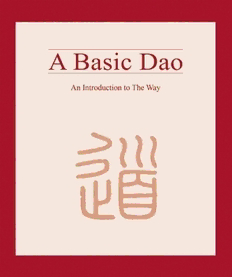Table Of ContentDAO-cover3.pdf 2008/6/24 21:17:36
Philosophy / Asian Studies
A
B A Basic Dao
“Emtpy the Mind. Maintain tranquility.” a
s
i
c
“The Dao that can be spoken of is not the D An Introduction to The Way
eternal Dao; The name that can be named is a
o
not the eternal name.”
C
M
“Who understands Others is learned; Who
Y
understands the Self is enlightened”
CM
MY
“Accomplish without boast. Accomplish
CY
without arrogance. Accomplish without
CMY
conceit.”
K
$12.95 US / $15.50 CAN
San Francisco
www.longriverpress.com
A Basic Dao
An Introduction to The Way
Compiled by Kuijie Zhou
Translated from the Chinese by
Philip Robyn
San Francisco
DAO-2.indd 1 2008/6/25 9:54:31
Compilation Copyright © 2008 Kuijie Zhou
Translation Copyright © 2008 Philip Robyn
All rights reserved
No part of this book may be reproduced without written permission of the
publisher
Published in the United States of America by
Long River Press
360 Swift Ave., Suite 48
South San Francisco, CA 94080
www.longriverpress.com
Editor: Chris Robyn
Book and cover design: Tommy Liu
First Edition, 2008
ISBN 978-1-59265-077-4
Library of Congress Cataloging-in-Publication Data
Zhou, Kuijie.
A basic Dao : an introduction to the way / compiled by Kuijie Zhou ; trans-
lated from the Chinese by Philip Robyn with Xia Weilan.
p. cm.
ISBN 978-1-59265-077-4 (pbk.)
1. Laozi. Dao de jing. 2. Philosophy, Chinese--To 221 B.C. I. Title.
BL1900.L35Z55 2008
299.5’1482--dc22
2008018290
DAO-2.indd 2 2008/6/25 9:54:31
On Self-Cultivation
Introduction
Of all the historical figures in the Chinese philosophical
canon, perhaps none has made a more significant contribu-
tion to Eastern and Western understanding of personal
spiritual and philosophical growth than Laozi (literally:
“Master Lao”). Today, Laozi’s works, above all the Dao
De Jing (Tao Te Ching) serve as a key philosophical and
even spiritual bridge for millions of people worldwide: how
they choose to lead their lives or look at the world. To read
Laozi is not the same as experiencing religious epiphany.
Rather, the wisdom of Laozi provides additional introspec-
tion through which life’s decisions and actions can take on
additional resonance and meaning.
Of Laozi’s origins little is known: most of what we
know remains shrouded in myth and mystery. He was
most likely born in the State of Chu during the Zhou Dy-
nasty in the 6th Century B.C. On the one hand, Laozi was
iii
DAO-2.indd 3 2008/6/25 9:54:31
A BASIC DAO
known to be a skilled record-keeper and an expert in the
rites and affairs of the State. By the same token, he also
represents the archetype of the Chinese philosopher/
hermit, and was said to have instructed Confucius and
even Buddha during his travels. Though Laozi attracted
a fair number of followers, he is said to have journeyed
in anonimity, preferring to note that, according to the
Dao, the place of humans in the world was of little sig-
nificance.
The legend of the Dao De Jing tells that Laozi, upon
journeying far to China’s west, at long last reached the
furthest frontier post of the empire. By this time his
name and reputation were known, and the garrison
commanders were on the look-out for “an old man jour-
neying West.” Before Laozi passed from the borders of
China forever, he was asked to leave a token of his wis-
dom behind. The result was the Dao De Jing, an approxi-
mately 5,000-Chinese character treatise. In the original
Chinese, it is a work of prose: it is everything and it is
iv
DAO-2.indd 4 2008/6/25 9:54:32
On Self-Cultivation
nothing. The Dao De Jing can reveal immense vistas
of knowledge and understanding, but how you read and
interpret such “revelations,” figuratively speaking, is
the key to how the text can help you. Thought it is not a
long work, it has offered generations of readers new in-
sights on philosophy and thought that can be applicable
to those in all walks of life. As with other Chinese phi-
losophers such as Sunzi, Confucius, and Mencius, “Dao-
ist” writings have been used and adapted for derivative
works in the field of business, sports, and personal im-
provement. These classic texts of Chinese philosophy
have proven themselves to be as viable today as they
were thousands of years ago.
The Dao De Jing gained popularity during the Han
Dynasty, as China began to enter a new Golden Age of
knowledge and understanding. This peaked during the
Tang Dynasty, where Laozi’s works became the gospel
truth of the Daoist school. The two remain integrally in-
tertwined to this day.
v
DAO-2.indd 5 2008/6/25 9:54:32
A BASIC DAO
The quotes in this book come from the writings of
Laozi. Each is pared with an historical corollary on the
opposite page. In this way, the essence of the historical
significance of the Dao De Jing is preserved; readers can
contemplate how The Dao can be used to influence their
lives in today’s rapidly-shrinking world. For those in-
volved in philosophy, philanthropy, meditation, self-help,
or the understanding of the place of humans in the uni-
verse, there is much than can still be gained from such
sage words.
vi
DAO-2.indd 6 2008/6/25 9:54:32
A BASIC DAO
DAO-2.indd 1 2008/6/25 9:54:33
DAO-2.indd 2 2008/6/25 9:54:33
DAO-2.indd 3 2008/6/25 9:54:34

